Abstract
Objective:
To determine injury types, natures, anatomical locations, recommended amount of time missed, and injury rates during weightlifting training.
Design and Setting:
We collected and analyzed medical injury records of resident athletes and during numerous training camps to generate an injury profile.
Subjects:
Elite US male weightlifters who were injured during training at the United States Olympic Training Centers.
Measurements:
United States Olympic Training Center weightlifting injury reports from a 6-year period were analyzed. Data were expressed as percentages and were analyzed via x2 tests.
Results:
The back (primarily low back), knees, and shoulders accounted for the most significant number of injuries (64.8%). The types of injuries most prevalent in this study were strains and tendinitis (68.9%). Injuries of acute (59.6%) or chronic (30.4%) nature were significantly more common than recurrent injuries and complications. The recommended number of training days missed for most injuries was 1 day or fewer (90.5%). Injuries to the back primarily consisted of strains (74.6%). Most knee injuries were tendinitis (85.0%). The majority of shoulder injuries were classified as strains (54.6%). Rates of acute and recurring injuries were calculated to be 3.3 injuries/1000 hours of weightlifting exposure.
Conclusions:
The injuries typical of elite weightlifters are primarily overuse injuries, not traumatic injuries compromising joint integrity. These injury pattems and rates are similar to those reported for other sports and activities.
Keywords: snatch, clean and jerk, resistance exercise, strains, tendinitis
Full text
PDF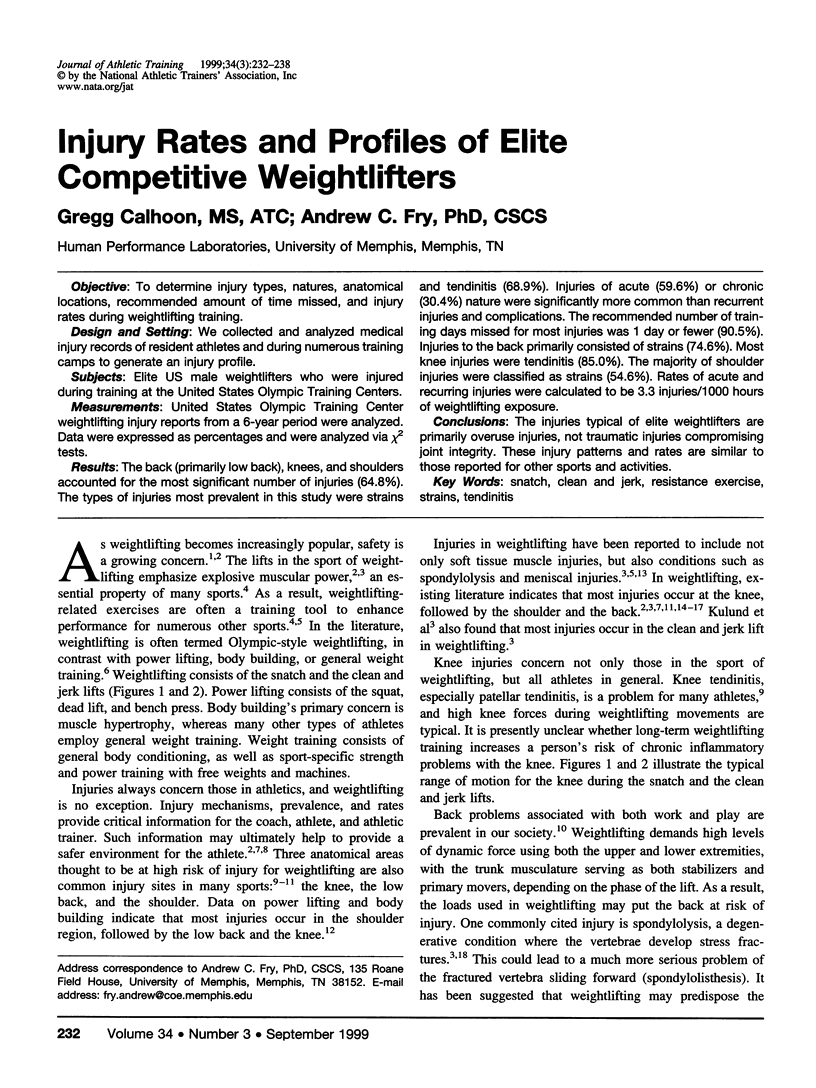
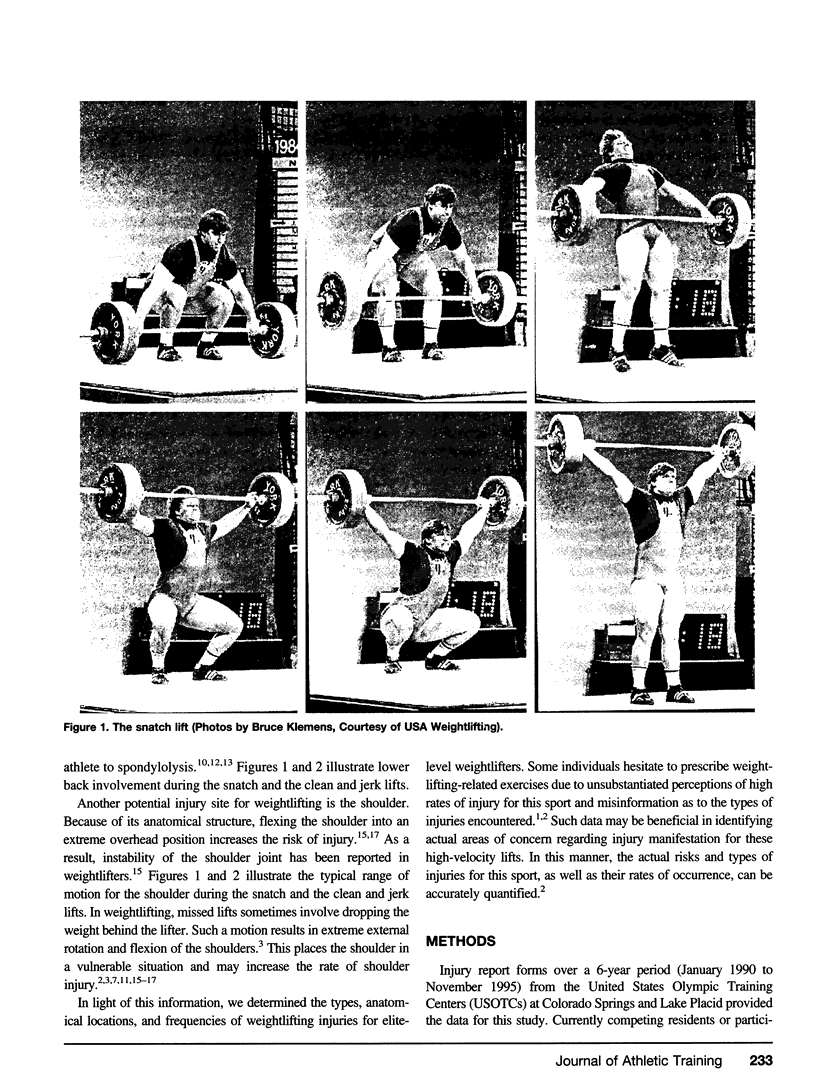

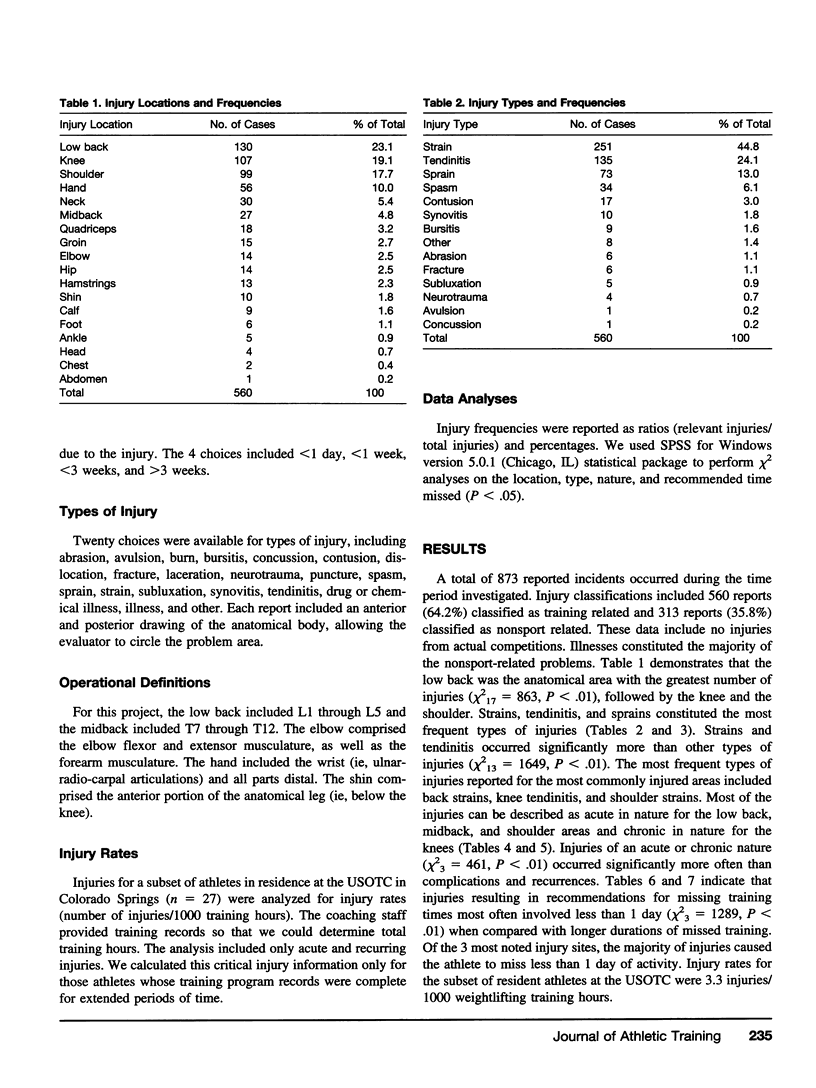
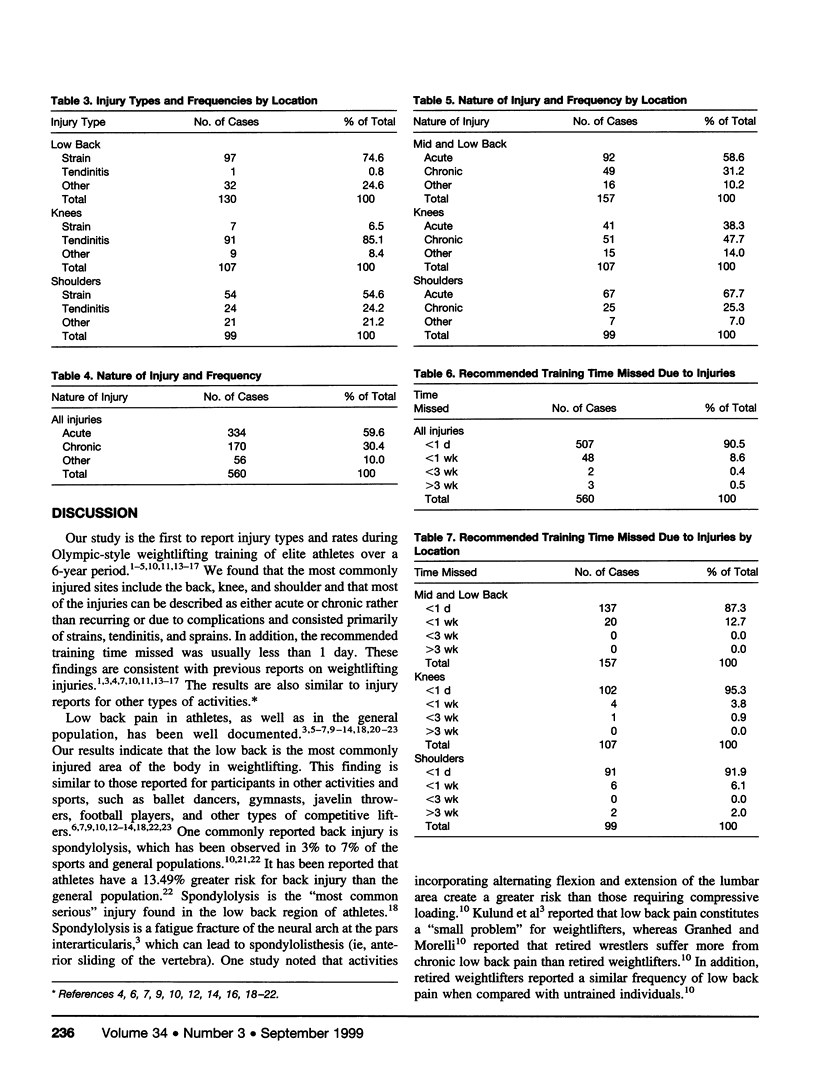
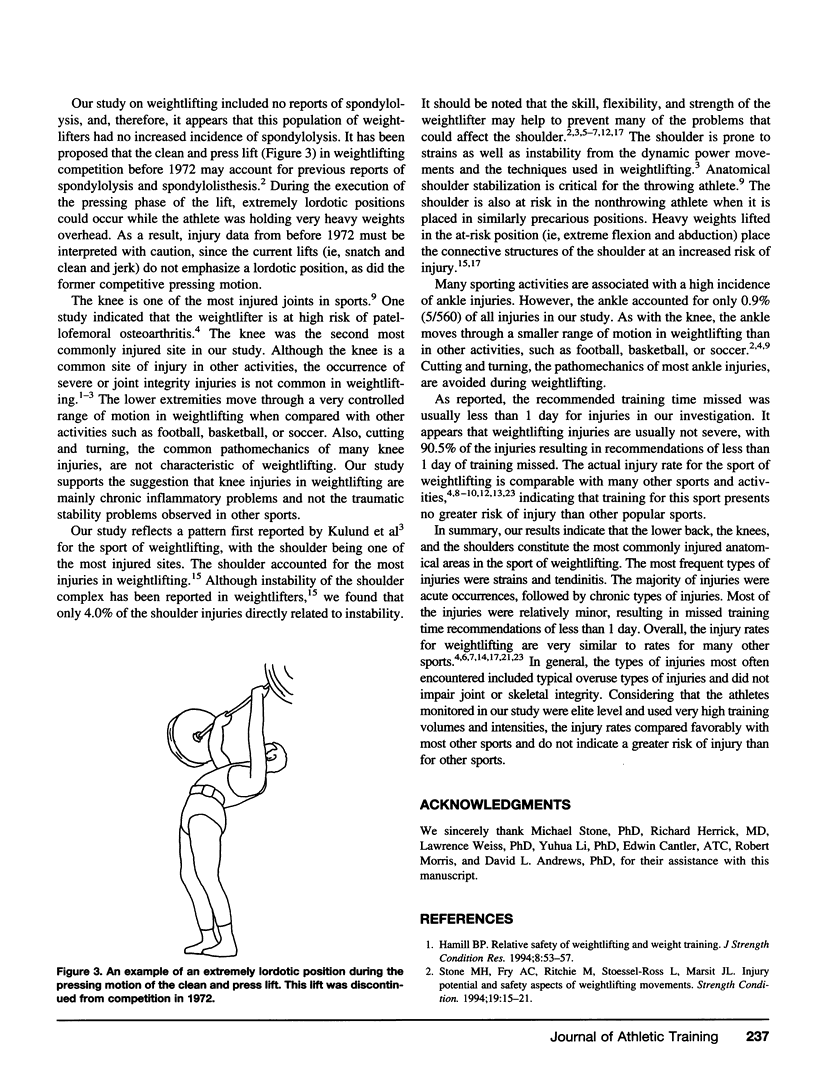

Images in this article
Selected References
These references are in PubMed. This may not be the complete list of references from this article.
- Alexander M. J. Biomechanical aspects of lumbar spine injuries in athletes: a review. Can J Appl Sport Sci. 1985 Mar;10(1):1–20. [PubMed] [Google Scholar]
- Basford J. R. Weightlifting, weight training and injuries. Orthopedics. 1985 Aug;8(8):1051–1056. doi: 10.3928/0147-7447-19850801-19. [DOI] [PubMed] [Google Scholar]
- DeHaven K. E., Lintner D. M. Athletic injuries: comparison by age, sport, and gender. Am J Sports Med. 1986 May-Jun;14(3):218–224. doi: 10.1177/036354658601400307. [DOI] [PubMed] [Google Scholar]
- Ferretti A., Puddu G., Mariani P. P., Neri M. The natural history of jumper's knee. Patellar or quadriceps tendonitis. Int Orthop. 1985;8(4):239–242. doi: 10.1007/BF00266866. [DOI] [PubMed] [Google Scholar]
- Goertzen M., Schöppe K., Lange G., Schulitz K. P. Verletzungen und Uberlastungsschäden beim Bodybuilding und Powerlifting. Sportverletz Sportschaden. 1989 Mar;3(1):32–36. doi: 10.1055/s-2007-993630. [DOI] [PubMed] [Google Scholar]
- Granhed H., Morelli B. Low back pain among retired wrestlers and heavyweight lifters. Am J Sports Med. 1988 Sep-Oct;16(5):530–533. doi: 10.1177/036354658801600517. [DOI] [PubMed] [Google Scholar]
- Green T. P., Allvey J. C., Adams M. A. Spondylolysis. Bending of the inferior articular processes of lumbar vertebrae during simulated spinal movements. Spine (Phila Pa 1976) 1994 Dec 1;19(23):2683–2691. [PubMed] [Google Scholar]
- Gross M. L., Brenner S. L., Esformes I., Sonzogni J. J. Anterior shoulder instability in weight lifters. Am J Sports Med. 1993 Jul-Aug;21(4):599–603. doi: 10.1177/036354659302100419. [DOI] [PubMed] [Google Scholar]
- Hefti F., Brunazzi M., Morscher E. Spontanverlauf bei Spondylolyse und Spondylolisthesis. Orthopade. 1994 Jun;23(3):220–227. [PubMed] [Google Scholar]
- Kujala U. M., Kettunen J., Paananen H., Aalto T., Battié M. C., Impivaara O., Videman T., Sarna S. Knee osteoarthritis in former runners, soccer players, weight lifters, and shooters. Arthritis Rheum. 1995 Apr;38(4):539–546. doi: 10.1002/art.1780380413. [DOI] [PubMed] [Google Scholar]
- König M., Biener K. Sportartspezifische Verletzungen im Gewichtheben. Schweiz Z Sportmed. 1990 Apr;38(1):25–30. [PubMed] [Google Scholar]
- Mazur L. J., Yetman R. J., Risser W. L. Weight-training injuries. Common injuries and preventative methods. Sports Med. 1993 Jul;16(1):57–63. doi: 10.2165/00007256-199316010-00005. [DOI] [PubMed] [Google Scholar]
- Mundt D. J., Kelsey J. L., Golden A. L., Panjabi M. M., Pastides H., Berg A. T., Sklar J., Hosea T. An epidemiologic study of sports and weight lifting as possible risk factors for herniated lumbar and cervical discs. The Northeast Collaborative Group on Low Back Pain. Am J Sports Med. 1993 Nov-Dec;21(6):854–860. doi: 10.1177/036354659302100617. [DOI] [PubMed] [Google Scholar]
- Neviaser T. J. Weight lifting. Risks and injuries to the shoulder. Clin Sports Med. 1991 Jul;10(3):615–621. [PubMed] [Google Scholar]
- Risser W. L. Musculoskeletal injuries caused by weight training. Guidelines for prevention. Clin Pediatr (Phila) 1990 Jun;29(6):305–310. doi: 10.1177/000992289002900602. [DOI] [PubMed] [Google Scholar]
- Rossi F., Dragoni S. Lisi istmiche lombari e sport. Rilievi radiologici e considerazioni statistiche. Radiol Med. 1994 Apr;87(4):397–400. [PubMed] [Google Scholar]
- Rothenberger L. A., Chang J. I., Cable T. A. Prevalence and types of injuries in aerobic dancers. Am J Sports Med. 1988 Jul-Aug;16(4):403–407. doi: 10.1177/036354658801600417. [DOI] [PubMed] [Google Scholar]
- Timm K. E., Wallach J. M., Stone J. A., Ryan E. J. Fifteen years of amateur boxing injuries/illnesses at the United States olympic training center. J Athl Train. 1993 Winter;28(4):330–334. [PMC free article] [PubMed] [Google Scholar]




